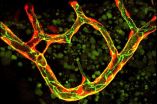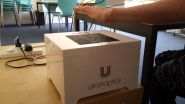Telling the time by color
2015-04-20
(Press-News.org) Research by scientists at The University of Manchester has revealed that the colour of light has a major impact on how our body clock measures the time of day.
It's the first time the impact of colour has been tested and demonstrates that colour provides a more reliable way of telling the time than measuring brightness.
In research being published on April 17th in the Open Access journal PLOS Biology, the researchers looked at the change in light around dawn and dusk to analyse whether colour could be used to determine time of day. Besides the well-known changes in light intensity that occur as the sun rises and sets they found that during twilight, light is reliably bluer than during the day.
The scientists next recorded electrical activity from the body clock while mice were shown different visual stimuli. They found that many of the cells there were more sensitive to changes in colour between blue and yellow than to changes in brightness.
The scientists then used measurements of the changes in the colour spectra taken from the top of the University's Pariser Building, to construct an artificial sky which recreated the daily changes in colour and brightness.
Mice were placed beneath the sky for several days and their body temperature was recorded. As expected for nocturnal creatures, the highest body temperatures occurred just after night fell when the sky turned a darker blue - indicating that their body clock was working optimally.
When just the brightness of the sky was changed, with no change in the colour, the mice became more active before dusk, demonstrating that their body clock wasn't properly aligned to the day night cycle.
Dr Timothy Brown from the Faculty of Life Sciences led the research: "This is the first time that we've been able to test the theory that colour affects the body clock in mammals. It has always been very hard to separate the change in colour to the change in brightness but using new experimental tools and a psychophysics approach we were successful."
He continues: "What's exciting about our research is that the same findings can be applied to humans. So in theory colour could be used to manipulate our clock, which could be useful for shift workers or travellers wanting to minimise jet lag."
INFORMATION:
[Attachments] See images for this press release:

ELSE PRESS RELEASES FROM THIS DATE:
2015-04-20
Cells of the vascular system of vertebrates can fuse with themselves. This process, which occurs when a blood vessel is no longer necessary and pruned, has now been described on the cellular level by Prof. Markus Affolter from the Biozentrum of the University of Basel. The findings of this study have been published in the journal PLOS Biology.
The vascular system is the supply network of the human organism and delivers oxygen and nutrients to the last corners of the body. So far, research on the vascular system has focused primarily on the formation of such vascular networks. ...
2015-04-20
The horticulturist who came up with the concept of 'evolution by natural selection' 27 years before Charles Darwin did should be more widely acknowledged for his contribution, states a new paper by a King's College London geneticist.
The paper, published in the Biological Journal of the Linnean Society, argues that Patrick Matthew deserves to be considered alongside Charles Darwin and Alfred Russel Wallace as one of the three originators of the idea of large-scale evolution by natural selection.
Furthermore, Matthew's version of evolution by natural section captures ...
2015-04-20
Human emotion can be transferred by technology that stimulates different parts of the hand without making physical contact with your body, a University of Sussex-led study has shown.
Sussex scientist Dr Marianna Obrist, Lecturer at the Department of Informatics, has pinpointed how next-generation technologies can stimulate different areas of the hand to convey feelings of, for example, happiness, sadness, excitement or fear.
For example, short, sharp bursts of air to the area around the thumb, index finger and middle part of the palm generate excitement, whereas sad ...
2015-04-20
Philadelphia, PA, April 20, 2015 - The search for genes that contribute to the risk for autism has made tremendous strides over the past 3 years. As this field has advanced, investigators have wondered whether the diversity of clinical features across patients with autism reflects heterogeneous sources of genetic risk.
If so, it was reasoned, then selecting a group of patients with very similar clinical features might result in a "purer", i.e., more genetically homogenous, group of patients, making it easier to find autism-related genes.
Results from a new study published ...
2015-04-20
Research has shown that, for a number of reasons, lesbian, gay, bisexual and transgender people are significantly more likely than heterosexuals to avoid or delay medical care.
For instance, LGBT individuals who are between the ages of 18 and 44 and single are less likely than heterosexuals to have the money or insurance for care, and even partnered gays and lesbians are twice as likely to be uninsured. The fear of stigma and homophobia can also keep LGBT people from seeking care. And many are afraid to disclose their sexual or gender identity to their physicians, which ...
2015-04-20
PHILADELPHIA - A protein produced by nerve cells appears to be elevated in the blood of those with an aggressive form of neuroblastoma. The finding, presented today at the American Association for Cancer Research 2015 Annual Meeting in Philadelphia, could potentially lead to a prognostic test for the disease or be used to monitor its progress.
Neuroblastoma is a pediatric cancer with varying types, ranging from spontaneously regressing to untreatable fatal tumors. Consequently, treatment strategies vary significantly between patients, encompassing different approaches ...
2015-04-20
A decrease in the amount of time spent eating and an increase in overnight fasting reduces glucose levels and may reduce the risk of breast cancer among women, report University of California, San Diego School of Medicine researchers in the journal Cancer Epidemiology, Biomarkers & Prevention.
The findings were presented at the American Association of Cancer Research's annual meeting in Philadelphia.
"Increasing the duration of overnight fasting could be a novel strategy to reduce the risk of developing breast cancer," said Catherine Marinac, UC San Diego doctoral candidate ...
2015-04-20
Early data in a preliminary human study show that an experimental immune system drug is generally safe and well tolerated in women with metastatic, triple-negative breast cancer, a persistently difficult form of the disease to treat.
Results of the early-phase clinical trial of the therapy, called MPDL3280A, which aims to restore the immune system's ability to recognize and attack cancer cells, are expected to be presented at the American Association for Cancer Research's 2015 Annual Meeting in Philadelphia from April 18-22. Triple-negative breast cancer cells lack expression ...
2015-04-20
TORONTO, April 20, 2015--Although ultrasound remains the primary imaging modality used in prenatal imaging, fetal MRI is playing an increasing role in further evaluation of fetuses suspected of congenital anomalies. As 3-T MRI scanners become more common due to their improved image signal-to-noise ratio and anatomical detail, the benefits of 3-T MRI must be weighed against potential risks to the fetus that may result from the higher field strength.
"MRI is playing an increasingly important role in the assessment of complex prenatal disease," said Kathleen E. Carey, MD, ...
2015-04-20
TORONTO, April 20, 2015--The design of inferior vena cava (IVC) filters for pulmonary embolism prophylaxis, once used almost exclusively for permanent implantation, has progressed to retrievable designs. However, complications can create scenarios in which the routine filter retrieval is either extremely difficult or impossible.
The use of advanced retrieval techniques, such as loop-snare, "sandwich," stiff wire or balloon realignment, forceps retrieval and excimer laser sheath can raise the overall success rate above 98%.
"Implementation of IVC filters is increasing ...
LAST 30 PRESS RELEASES:
[Press-News.org] Telling the time by color


